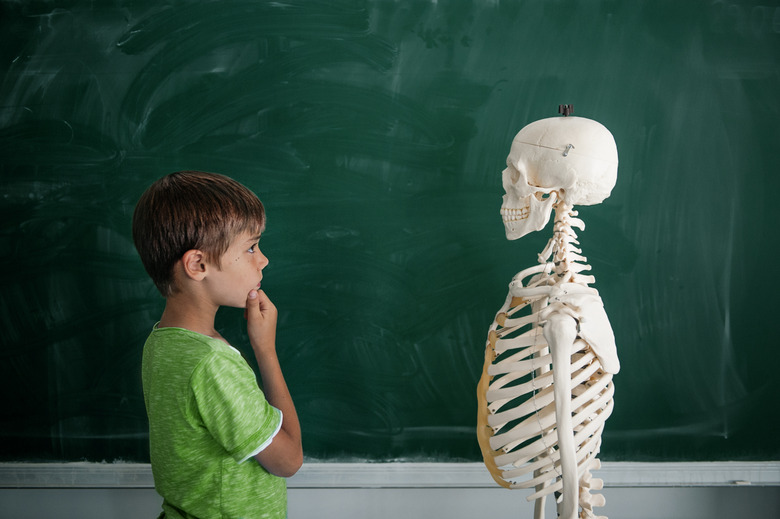Skeleton Project Ideas
The skeleton provides vital support and protection for the body's internal organs and structures. Explore the intricate world of the skeletal system with a variety of skeleton projects designed to engage students in hands-on and interactive learning activities. Children as young as kindergarten grasp a basic understanding of the shape and role of the skeleton, while older children are ready for in-depth investigations and analyses of skeletal systems.
Skeleton Crafts
Skeleton Crafts
Skeleton craft projects introduces younger children to the concept of bone structure, function and strength. Even kindergarten children can engage with a macaroni craft project where they fill in outlines of a human body with different pieces of dry macaroni. Encourage students to select pieces that fit the size and shape of different body parts like an elbow macaroni for an elbow or broken pieces of spaghetti for ribs.
Older children are intrigued by the mysterious world of dinosaurs. Create a fossil project in which students collect and clean different types of chicken or pig bones before pressing them into clay blocks as if they were fossilized. Supplement the assignment with research about what we can learn from dinosaur fossils. For a less science-minded activity, use clay or sugar molding kits to make decorative skulls in honor of the Day of the Dead, a Mexican holiday on November 1 that celebrates deceased loved ones.
Human Skeletal System
Human Skeletal System
Hands-on projects and experiments illuminate the well-hidden world of the human skeleton. Investigate one of the primary functions of the human skeletal system by testing bone strength. A chicken bone is relatively sturdy when bent, but a chicken bone soaked in vinegar is sapped of its supply of sturdy calcium deposits, resulting in a weak and brittle bone. Devise a project in which students investigate the effects of vinegar on bones and determine what the implications are for the building of strong human skeletons.
Though all bones are made of the same basic stuff and perform generally the same functions, some of the greatest variations in bones occur in bone joint shape. Ask groups of students to select a type of joint and devise a demonstration of the joint, its shape and function, as well as a replica or model of the joint found in a house hold object. For example, a group investigating the hinge joint may bring in a door hinge, while a group examining a ball and socket joint might demonstrate with a pivot-head broom or vacuum.
Types of Skeletal Systems
Types of Skeletal Systems
Examining the skeletal systems of other animals allows students to make comparisons between different bone features. Owl pellets are the regurgitated remains of small rodents, birds and lizards that owls eat. The bones are too difficult to digest so owls vomit dry pellets filled with skeletal remains. Dissect owl pellets and ask students to identify the types of skeletons present in their specimen to make conclusions about owl diets.
A creative project idea is to assign small groups of students an animal or a classification of animals to compare to humans in terms of skeletal systems. For example, one group may compare human skeletons to gorilla skeletons, while another group compares humans to pig skeletons. Another options is to ask students to compare human skeletons to animal groups like mammals, fish or birds.
Cite This Article
MLA
Wahlig, Hannah. "Skeleton Project Ideas" sciencing.com, https://www.sciencing.com/skeleton-project-ideas-12745488/. 15 November 2019.
APA
Wahlig, Hannah. (2019, November 15). Skeleton Project Ideas. sciencing.com. Retrieved from https://www.sciencing.com/skeleton-project-ideas-12745488/
Chicago
Wahlig, Hannah. Skeleton Project Ideas last modified March 24, 2022. https://www.sciencing.com/skeleton-project-ideas-12745488/
